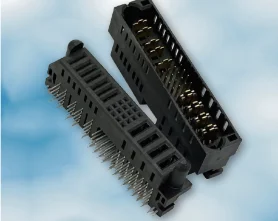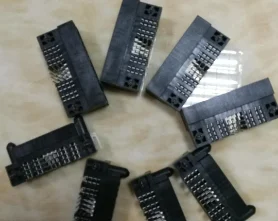MedlonUploaded:2024-02-27Browse:2453

Uninterrupted and reliable power supply is essential for our daily lives, whether it's for our homes, offices, or on-the-go needs. That's why we are excited to introduce our range of high-quality and dependable power connectors. Designed to keep you connected and powered on, our connectors cater to a variety of devices and come equipped with advanced safety features. From traditional wall adapters to portable power banks, our products are built to withstand the demands of modern life and ensure that you never run out of power when you need it most. So why settle for less when it comes to powering your devices? Choose our power connectors and stay connected and powered on at all times.
At our company, we aim to simplify the process of connecting with our advanced power connectors. Our connectors are designed to provide a seamless and efficient way to power and connect various devices, making your life easier and more convenient. With our innovative technology and superior quality materials, our power connectors offer reliable and stable connections, ensuring that your devices receive the power they need. Trust in our simplified approach to connections and let us help streamline your daily tasks.

1.What is the difference between a power connector and an electrical socket?
A power connector is a device used to connect an electronic device to a power source, such as a wall outlet or power strip. It typically has two or three prongs that fit into corresponding slots in the socket. An electrical socket, also known as an outlet or receptacle, is a fixed device installed in a wall or power strip that provides a connection point for a power connector. It has slots or holes that match the prongs of a power connector and allows electricity to flow from the power source to the connected device. In summary, a power connector is the plug that goes into the socket, while the electrical socket is the fixed outlet that provides the connection point for the power connector.
2.How do I identify the polarity of a power connector?
1. Check the label or manual: The easiest way to identify the polarity of a power connector is to check the label or manual that came with the device. It should clearly state which pin is positive (+) and which is negative (-). 2. Look for markings on the connector: Some power connectors may have markings on them to indicate the polarity. The positive pin may have a plus sign (+) or a red color, while the negative pin may have a minus sign (-) or a black color. 3. Use a multimeter: If there are no markings on the connector, you can use a multimeter to determine the polarity. Set the multimeter to measure DC voltage and touch the positive probe to one pin of the connector and the negative probe to the other pin. If the multimeter reads a positive voltage, then the pin you touched with the positive probe is the positive pin. If it reads a negative voltage, then the pin you touched with the negative probe is the positive pin. 4. Check the device: You can also check the device itself to determine the polarity of the power connector. Look for any markings or labels near the power input that indicate the polarity. You can also refer to the device's manual or contact the manufacturer for assistance. 5. Use a polarity tester: If you have a polarity tester, you can use it to determine the polarity of the power connector. Simply plug the tester into the power connector and it will indicate which pin is positive and which is negative. Note: It is important to identify the polarity of a power connector correctly before connecting it to a device. Reversing the polarity can damage the device or cause it to malfunction.
3.Can I use power connectors for both input and output functions?
No, power connectors are designed for either input or output functions, not both. They are designed to transfer power from a power source to a device or from a device to a power source, but not both simultaneously. Attempting to use a power connector for both input and output functions could result in damage to the connector or the devices connected to it. It is important to use the correct type of connector for each function to ensure safe and proper operation.

4.How do I ensure proper grounding for my power connector?
1. Use a three-pronged power cord: The most important step in ensuring proper grounding for your power connector is to use a three-pronged power cord. This type of cord has a third prong, known as the ground pin, which is responsible for connecting the device to the ground. 2. Check the outlet: Make sure the outlet you are using is properly grounded. You can do this by using a circuit tester or by plugging in a device and checking for a proper connection. 3. Use a surge protector: A surge protector not only protects your devices from power surges, but it also provides an additional layer of grounding. Make sure to use a surge protector that has a built-in ground indicator light to ensure proper grounding. 4. Avoid using extension cords: If possible, avoid using extension cords as they can interfere with the grounding process. If you must use an extension cord, make sure it is properly grounded and in good condition. 5. Keep the power cord away from water: Water is a good conductor of electricity, so it is important to keep your power cord away from any sources of water to prevent the risk of electric shock. 6. Use a ground loop isolator: If you are experiencing humming or buzzing noises from your audio or video equipment, it may be due to a ground loop. In this case, using a ground loop isolator can help eliminate the noise and improve grounding. 7. Consult a professional: If you are unsure about the grounding of your power connector, it is best to consult a professional electrician. They can inspect your wiring and make any necessary adjustments to ensure proper grounding.
5.Are there any safety precautions to consider when handling power connectors?
1. Turn off the power: Before handling any power connectors, make sure to turn off the power source to avoid any electrical shock. 2. Wear protective gear: It is recommended to wear protective gear such as gloves, safety glasses, and non-conductive footwear when handling power connectors. 3. Inspect the connectors: Before use, inspect the connectors for any damage or wear and tear. Do not use damaged connectors as they can cause electrical hazards. 4. Use the correct tools: Use the appropriate tools for handling power connectors, such as insulated screwdrivers or pliers, to avoid accidental contact with live wires. 5. Avoid contact with water: Keep the connectors and your hands dry when handling them. Water can conduct electricity and increase the risk of electrical shock. 6. Do not touch the metal parts: Avoid touching the metal parts of the connectors, especially when they are connected to a power source. 7. Do not force connections: Do not force connectors into sockets or plugs. If they do not fit easily, there may be a problem with the connection, and forcing it can cause damage or electrical hazards. 8. Keep connectors away from heat sources: Do not expose connectors to heat sources, as they can melt or cause a fire. 9. Do not overload connectors: Make sure not to overload connectors with too many devices or appliances, as it can cause overheating and damage. 10. Follow manufacturer's instructions: Always follow the manufacturer's instructions for handling and using power connectors to ensure safety.
6.What is the average lifespan of a power connector?
The average lifespan of a power connector can vary greatly depending on the quality of the connector, frequency of use, and environmental factors. In general, a well-made power connector can last anywhere from 5 to 10 years. However, some connectors may last much longer, while others may fail after only a few years. It is important to regularly inspect and maintain power connectors to ensure their longevity.

7.Are there any compatibility issues between power connectors and specific devices or brands?
Yes, there can be compatibility issues between power connectors and specific devices or brands. This is because different devices and brands may use different types of power connectors, such as USB, AC, or DC connectors. Additionally, some devices may require a specific voltage or amperage from the power connector, which may not be compatible with other devices. It is important to check the specifications of both the device and the power connector to ensure compatibility before use.
8.Can a power surge damage a power connector?
Yes, a power surge can potentially damage a power connector. A power surge is a sudden increase in the electrical current flowing through a circuit, which can cause damage to electronic devices and their components. If the power surge is strong enough, it can overload and damage the power connector, causing it to fail or malfunction. It is important to use surge protectors to protect electronic devices from power surges.
9.What is the maximum voltage and current rating for a standard power connector?
The maximum voltage and current rating for a standard power connector can vary depending on the specific type and design of the connector. However, in general, most standard power connectors have a maximum voltage rating of 250V and a maximum current rating of 10A. It is important to always check the specifications of a specific power connector to ensure it is suitable for the intended voltage and current requirements.

10.Can I use any power connector for my device or do I need a specific type?
It depends on the device and its power requirements. Some devices may have specific power connectors that are designed to fit only that device, while others may have more universal power connectors that can be used with a variety of devices. It is important to check the specifications of your device to determine the type of power connector it requires. Using the wrong power connector could potentially damage your device or cause it to not function properly.
11.Are there any regulations or standards for power connector manufacturing?
Yes, there are several regulations and standards that govern the manufacturing of power connectors. These include: 1. International Electrotechnical Commission (IEC) standards: The IEC sets international standards for electrical and electronic components, including power connectors. These standards cover aspects such as dimensions, performance, and safety requirements. 2. Underwriters Laboratories (UL) standards: UL is a global safety certification company that sets standards for electrical and electronic products, including power connectors. UL standards cover aspects such as safety, performance, and environmental impact. 3. Restriction of Hazardous Substances (RoHS) directive: This directive restricts the use of certain hazardous substances in electrical and electronic equipment, including power connectors. It aims to protect human health and the environment. 4. Registration, Evaluation, Authorization, and Restriction of Chemicals (REACH) regulation: This regulation aims to ensure the safe use of chemicals in products, including power connectors. It requires manufacturers to register and provide information on the substances used in their products. 5. National and regional standards: Many countries and regions have their own standards for power connectors, which may be based on international standards or have additional requirements. Manufacturers of power connectors must comply with these regulations and standards to ensure the safety, performance, and environmental impact of their products.